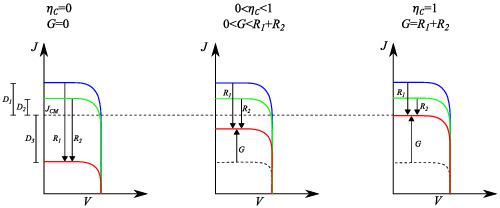当前位置:
X-MOL 学术
›
Prog. Photovoltaics
›
论文详情
Our official English website, www.x-mol.net, welcomes your
feedback! (Note: you will need to create a separate account there.)
Experimental coupling process efficiency and benefits of back surface reflectors in photovoltaic multi‐junction photonic power converters
Progress in Photovoltaics ( IF 8.0 ) Pub Date : 2021-01-13 , DOI: 10.1002/pip.3391 Esther Lopez 1, 2 , Oliver Höhn 1 , Meike Schauerte 1 , David Lackner 1 , Michael Schachtner 1 , S. Kasimir Reichmuth 1 , Henning Helmers 1
Progress in Photovoltaics ( IF 8.0 ) Pub Date : 2021-01-13 , DOI: 10.1002/pip.3391 Esther Lopez 1, 2 , Oliver Höhn 1 , Meike Schauerte 1 , David Lackner 1 , Michael Schachtner 1 , S. Kasimir Reichmuth 1 , Henning Helmers 1
Affiliation

|
Current matching is crucial to maximize the efficiency of two‐terminal multi‐junction photovoltaic devices. However, even in perfectly designed devices, deviation from the target operating temperature and consequent changes in the subcell absorptances causes current mismatch between the subcell currents even at constant spectral conditions. Fortunately, luminescence coupling from current‐overproducing subcells to current limiting subcells mitigates this effect. In this work, the coupling process efficiency in three‐junction photonic power converters based on GaAs/AlGaAs rear hetero‐junction subcells is experimentally quantified. A coupling process efficiency of 32% ± 9% from top and middle subcells to the limiting bottom subcell is found. Under constant monochromatic illumination, the observed coupling reduces the current mismatch, induced by raising the temperature from current matched conditions at 25°C to 70°C, from 4.4% to 1.6%. Furthermore, in this work, three‐junction photonic power converters with back surface reflectors are implemented. Those reflectors improve the device response at elevated temperatures by increasing the optical path length in the limiting subcell. It is shown experimentally how a back reflector effectively redirects photons that are emitted by the bottom subcell towards the upper subcells to reinforce luminescence coupling.
中文翻译:

光伏多结光子功率转换器中的实验耦合过程效率和背面反射器的优势
电流匹配对于最大化两端多结光伏器件的效率至关重要。但是,即使在设计完善的设备中,即使在恒定的光谱条件下,偏离目标工作温度以及子电池吸收率的随之变化也会导致子电池电流之间的电流失配。幸运的是,从产生电流的子电池到限流子电池的发光耦合减轻了这种影响。在这项工作中,通过实验对基于GaAs / AlGaAs后异质结子电池的三结光子功率转换器中的耦合过程效率进行了量化。发现从顶部和中间子电池到极限底部子电池的耦合处理效率为32%±9%。在恒定的单色照明下,观察到的耦合减小了电流失配,通过将当前匹配条件下的温度从25°C升高到70°C引起的温度从4.4%升高到1.6%。此外,在这项工作中,还实现了带有背面反射器的三结型光子功率转换器。这些反射器通过增加限制子电池中的光路长度来改善高温下的设备响应。实验上显示了后反射器如何有效地将底部子电池发射的光子重定向到上部子电池以增强发光耦合。这些反射器通过增加限制子电池中的光路长度来改善高温下的设备响应。实验上显示了后反射器如何有效地将底部子电池发射的光子重定向到上部子电池,以增强发光耦合。这些反射器通过增加限制子电池中的光路长度来改善高温下的设备响应。实验上显示了后反射器如何有效地将底部子电池发射的光子重定向到上部子电池以增强发光耦合。
更新日期:2021-03-10
中文翻译:

光伏多结光子功率转换器中的实验耦合过程效率和背面反射器的优势
电流匹配对于最大化两端多结光伏器件的效率至关重要。但是,即使在设计完善的设备中,即使在恒定的光谱条件下,偏离目标工作温度以及子电池吸收率的随之变化也会导致子电池电流之间的电流失配。幸运的是,从产生电流的子电池到限流子电池的发光耦合减轻了这种影响。在这项工作中,通过实验对基于GaAs / AlGaAs后异质结子电池的三结光子功率转换器中的耦合过程效率进行了量化。发现从顶部和中间子电池到极限底部子电池的耦合处理效率为32%±9%。在恒定的单色照明下,观察到的耦合减小了电流失配,通过将当前匹配条件下的温度从25°C升高到70°C引起的温度从4.4%升高到1.6%。此外,在这项工作中,还实现了带有背面反射器的三结型光子功率转换器。这些反射器通过增加限制子电池中的光路长度来改善高温下的设备响应。实验上显示了后反射器如何有效地将底部子电池发射的光子重定向到上部子电池以增强发光耦合。这些反射器通过增加限制子电池中的光路长度来改善高温下的设备响应。实验上显示了后反射器如何有效地将底部子电池发射的光子重定向到上部子电池,以增强发光耦合。这些反射器通过增加限制子电池中的光路长度来改善高温下的设备响应。实验上显示了后反射器如何有效地将底部子电池发射的光子重定向到上部子电池以增强发光耦合。











































 京公网安备 11010802027423号
京公网安备 11010802027423号